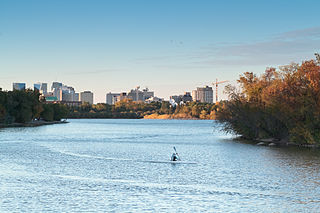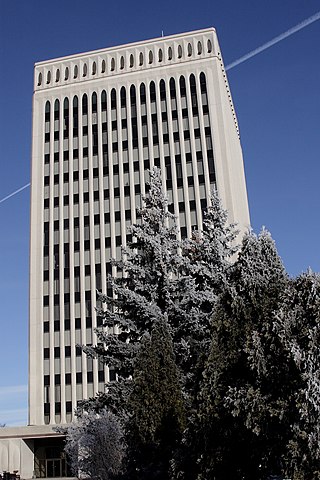
Minoru Yamasaki was an American architect, best known for designing the original World Trade Center in New York City and several other large-scale projects. Yamasaki was one of the most prominent architects of the 20th century. He and fellow architect Edward Durell Stone are generally considered to be the two master practitioners of "New Formalism".

Oscar Ribeiro de Almeida Niemeyer Soares Filho, known as Oscar Niemeyer, was a Brazilian architect considered to be one of the key figures in the development of modern architecture. Niemeyer was best known for his design of civic buildings for Brasília, a planned city that became Brazil's capital in 1960, as well as his collaboration with other architects on the headquarters of the United Nations in New York. His exploration of the aesthetic possibilities of reinforced concrete was highly influential in the late 20th and early 21st centuries.

Regina is the capital city of the Canadian province of Saskatchewan. The city is the second-largest in the province, after Saskatoon, and is a commercial centre for southern Saskatchewan. As of the 2021 census, Regina had a city population of 226,404, and a Metropolitan Area population of 249,217. It is governed by Regina City Council. The city is surrounded by the Rural Municipality of Sherwood No. 159.

Modern architecture, or modernist architecture, was an architectural movement or architectural style based upon new and innovative technologies of construction, particularly the use of glass, steel, and reinforced concrete; the idea that form should follow function (functionalism); an embrace of minimalism; and a rejection of ornament. It emerged in the first half of the 20th century and became dominant after World War II until the 1980s, when it was gradually replaced as the principal style for institutional and corporate buildings by postmodern architecture. According to Le Corbusier the roots of the movement were to be found in the works of Eugène Viollet le duc.

The University of Regina is a public research university located in Regina, Saskatchewan, Canada. Founded in 1911 as a private denominational high school of the Methodist Church of Canada, it began an association with the University of Saskatchewan as a junior college in 1925, and was disaffiliated by the Church and fully ceded to the university in 1934; in 1961 it attained degree-granting status as the Regina Campus of the University of Saskatchewan. It became an autonomous university in 1974. The University of Regina has an enrolment of over 15,000 full and part-time students. The university's student newspaper, The Carillon, is a member of CUP.

The Price Tower is a nineteen-story, 221-foot-high tower at 510 South Dewey Avenue in Bartlesville, Oklahoma. It was built in 1956 to a design by Frank Lloyd Wright. It is the only realized skyscraper by Wright, and is one of only two vertically oriented Wright structures extant; the other is the S.C. Johnson Wax Research Tower in Racine, Wisconsin.
This is a timeline of architecture, indexing the individual year in architecture pages. Notable events in architecture and related disciplines including structural engineering, landscape architecture, and city planning. One significant architectural achievement is listed for each year.
The year 1967 in architecture involved some significant architectural events and new buildings.

CBK is a Canadian public radio station licensed to Watrous, Saskatchewan. It broadcasts the CBC Radio One network as a Class A clear-channel AM station powered at 50,000 watts around the clock from a non-directional antenna near Watrous.

Government House, Regina, Saskatchewan, Canada, was constructed as a residence for the lieutenant governor of the North-West Territories, whose territorial headquarters were in Regina until the provinces of Saskatchewan and Alberta were created out of the Territories in 1905 and Regina became the capital of Saskatchewan.

Wascana Centre is a 930-hectare urban park built around Wascana Lake in Regina, Saskatchewan, Canada, established in 1912 with a design from renowned architect Thomas Mawson. The park is designed around the Saskatchewan Legislative Building and Wascana Lake. High-profile features include the University of Regina, Royal Saskatchewan Museum, Conexus Arts Centre, Saskatchewan Science Centre, and CBC Regional Broadcast Centre. Wascana Centre brings together lands and buildings owned by the City of Regina, University of Regina, and Province of Saskatchewan. The park is located immediately south of the city's downtown core, bordered by residential areas on the east, south and west, and on the south-east edge it spills out onto open Saskatchewan prairie along Wascana Creek.

Many historically significant buildings in Regina, Saskatchewan were lost during the period 1945 through approximately 1970 when the urge to "modernize" overtook developers' and city planners' sense of history and heritage. The old warehouse district to the north of the old CPR tracks was Regina's original commercial raison d'être once Lieutenant-Governor Edgar Dewdney had established the site of his considerable landholdings as the Territorial Capital. With the significant conversion of shipping of commercial goods from train to truck and cancellation of passenger service on the railway, the Warehouse District immediately adjacent to the train line has ceased to be exclusively industrial in character. Some areas of the Warehouse District have been transformed into a shopping, entertainment and residential precinct.

The Gustavo Capanema Palace, also known architecturally as the Ministry of Education and Health Building, is a government office building in the Centro district of Rio de Janeiro, Brazil. As the first modernist project in Brazil, it is historically important to the architectural development of Modernism in Brazil and has been placed on Brazil's UNESCO tentative list.
Estlin is a hamlet in Saskatchewan, Canada 22 km south of Regina. Little remains of the former village, except for some private residences and the rail lines near the town. The town once contained an elevator.

Queen Elizabeth II Court is the city block containing Regina City Hall, a 16-storey office tower in Regina, Saskatchewan, Canada. The city hall is built in the International Style.

The architecture of Jacksonville is a combination of historic and modern styles reflecting the city's early position as a regional center of business. According to the National Trust for Historic Preservation, there are more buildings built before 1967 in Jacksonville than any other city in Florida, though few structures in the city center predate the Great Fire of 1901. Numerous buildings in the city have held state height records, dating as far back as 1902, and last holding a record in 1981.
Clifford Donald Wiens was a Canadian writer, poet, designer and architect. Clifford Wiens played a crucial role in the development of corporate modern architecture and the broader Expressionist Movement in postwar Mid-West Canada. Wiens was defined as a poetic architect and his projects reflect this through their communication with both the client and the user. This poetry was best shown in his work on the University of Regina Heating and Cooling Building.

The Central Heating and Cooling Plant at the University of Regina, often referred to simply as the Heating and Cooling Plant is a building in by architect Clifford Wiens that provides heated and chilled water to University of Regina campus buildings.
Barbara Cass-Beggs was an English-born Canadian folk song collector, singer and teacher. She was director of the University Settlement Music School at the University of Toronto and was a faculty member of the Regina Conservatory of Music as vocal teacher. Cass-Beggs set up the Regina Junior Concery Society in 1957 and collected folk songs for use in teaching. She was a private music educator to children and did pre-school teacher music courses at Algonquin College's early childhood education. An award and scholarship are named after Cass-Beggs whose personal objects are in the collection of the Provincial Archives of Saskatchewan.















